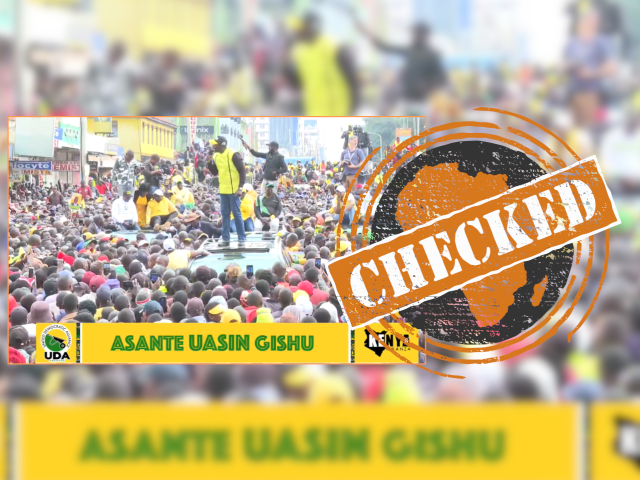IN SHORT: With the two leading candidates in Kenya's 2022 general election still at loggerheads, an apology from one of them, as claimed in a video on social media, would be newsworthy. But it hasn’t happened.
A TikTok video, posted on 5 April 2023 and liked thousands of times, is captioned: “Raila apologies to president Ruto for disturbing his government in demonstrations.”
The video shows Kenyan opposition leader Raila Odinga addressing an audience on a podium. He says: “On behalf of my team and myself, I, in front of this congregation gathered here, prayer breakfast, tender my apology to my brother.”
The clip then shows Odinga and Kenya’s president William Ruto embracing as the crowd applauds. The clip has also been reposted over 2,100 times and received over 300 comments.
The sound from the video was also used by other TikTok users, spreading the claim even further.
Odinga started leading weekly demonstrations on 20 March to protest the high cost of living and the results of the August 2022 general election, among other grievances. Odinga lost the presidential election to Ruto.
He called off the protests after Ruto agreed to a bipartisan parliamentary process to look into some of the grievances.
Odinga accepted the olive branch, saying that it came after wide consultations, including with religious leaders. But he has said the protests will resume if the talks fail.
But did Odinga apologise to Ruto for leading the marches, many of which saw clashes between demonstrators and security forces?

Clip taken from 2018 video of leaders apologising to one another
In the TikTok video, Odinga's words give a clue as to where the event took place – he mentioned that he was addressing a congregation gathered for a prayer breakfast.
A YouTube search using keywords such as “Prayer breakfast Raila apology” led to several videos of the event. This video was taken at the country’s national prayer breakfast on 31 May 2018. Then president Uhuru Kenyatta had called Ruto, his deputy at the time, and two opposition leaders, Odinga and Kalonzo Musyoka, to the podium.
Kenyatta led the way in apologising to and asking for forgiveness from his political opponents, including during the 2017 election campaign.
The other leaders also apologised for having said or done anything hurtful.
Odinga’s words in the TikTok video are from minute 2:40 in the 2018 video. They were an apology addressed directly to Kenyatta.
The hug between Odinga and Ruto came a little later, at minute 8:35, after all the leaders had made their speeches.
There were protests in 2017 led by Odinga following the annulment of that year’s election, which led to what is known as the “handshake agreement” between Odinga and Kenyatta in March 2018.
The TikTok video is from the 2018 prayer breakfast and has nothing to do with the opposition-led demonstrations in 2023. The claim that Odinga apologised to Ruto for the later demonstrations is false.
Republish our content for free
For publishers: what to do if your post is rated false
A fact-checker has rated your Facebook or Instagram post as “false”, “altered”, “partly false” or “missing context”. This could have serious consequences. What do you do?
Click on our guide for the steps you should follow.
Publishers guideAfrica Check teams up with Facebook
Africa Check is a partner in Meta's third-party fact-checking programme to help stop the spread of false information on social media.
The content we rate as “false” will be downgraded on Facebook and Instagram. This means fewer people will see it.
You can also help identify false information on Facebook. This guide explains how.




Add new comment